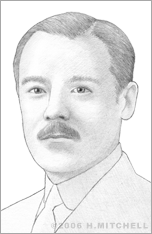Ernst Alexanderson
Electrical engineer and inventor, Ernst Fredrick Werner Alexanderson, developed pioneering technological concepts during the early 20th century that contributed to the birth of the broadcasting industry. Alexanderson’s numerous discoveries formed the basis for the technology that would make the transmission of voice, music, and pictures possible. His more than 340 patents and affiliations with some of the world’s foremost scientists and business executives made him a central figure in the early years of broadcasting and earned him a place on the list of the most prolific U.S.-based inventors of all time.
Born on January 25, 1878, in Upsala, Sweden, Alexanderson graduated from the Royal Institute of Technology in Stockholm with a degree in electrical engineering in 1900 and went on to do post-graduate work at the Technical University in Berlin, Germany. There, he read the book “Alternating Current Phenomena” by General Electric’s Dr. Charles P. Steinmetz and was inspired to travel to the United States with the hope of having an opportunity to meet and work with this great man. He emigrated to the U.S. in 1902 and first worked for C&C Electric Company in New Jersey before joining GE under Steinmetz in Schenectady, N.Y.
There, Alexanderson was assigned the task of building a variation of a spark transmitter (used to transmit dots and dashes for communicating in Morse code) that could produce a continuous wave suitable for carrying the human voice. This would necessitate a much higher-frequency alternating generator than was available at the time. These machines were maxed out at around 60 Hertz then; Alexanderson was asked to build a machine that could generate a 100,000 Hertz frequency.
Under the guidance of Canadian radio pioneer, Professor Reginald Fessenden, Alexanderson was able to construct such a machine within just two years. He and Fessenden demonstrated a two-kilowatt, 100-kilohertz alternator in December of 1906. Installed in Fessenden’s transmitter, it enabled the device to carry the human voice for the first time over telegraph wires. Subsequent to this event, the Alexanderson Alternator was considered the world’s first radio broadcast and quickly became used for many great experiments and broadcasts of all kinds, which included use by President Woodrow Wilson in his direction of forces at the close of World War I. Alexanderson was eventually able to build even higher power alternators, of up to 500,000 watts.

These developments spurred the establishment of the Radio Corporation of America (RCA) in 1919, where Alexanderson worked as chief engineer for several years, in addition to continuing research for GE. He returned to work full-time for GE in 1924. For the next decade he worked on technologies that would enable picture transmission and used the station WGY (now CBS affiliate WRGB) in Schenectady, New York, as a testing laboratory for many of his technologies. In 1926, he was able to send the first facsimile from the United States to Europe, with the picture sent on the transmission side, showing up on the receiving side in just two minutes. He had already begun experimenting with moving picture transmission, i.e., television, in 1925, using local test television sets. In 1927, he demonstrated the first home reception of television at his own home in Schenectady, using high-frequency neon lamps and a perforated scanning disc. He unveiled his concept of microwave television transmission to the general public on January 13, 1928.
By May of that year, the first television newscasts were broadcast regularly from WGN in Schenectady. The first remote broadcast was conducted in August of that year, and in September of 1928, the first television drama, a production of “The Queen’s Messenger,” was broadcast to just a couple of hundred television sets, which then had slightly fuzzy, pinkish screens. This, of course, was just the beginning. Television sets began to be sold by the thousands by the mid-1930s, after Philo Farnsworth demonstrated the world’s first complete all-electronic model.
Alexanderson continued to work on improvements to broadcast and audio recording systems, developing a system for transmission of color television in 1930; an audio recording system that used film in 1927; a telephone system for connecting trains; a telegraphy system for the military; and a radar altimeter, which predated the radar system developed by the British 20 years later. During World War II, he designed the amplidyne, an electrodynamic amplifier. In 1945, he invented a portable sound recorder, and in 1955, he patented a color television receiver developed for RCA, where he worked as a consultant after his retirement from GE in 1948.
He was elected to the Royal Academy of Science in Sweden in 1924 and was awarded the Edison Medal from the American IEEE and the Cedergren Medal in 1944. He was granted the Royal Danish Medal in 1946 and was recognized with numerous other honors and awards throughout the course of his long career. Alexanderson died on May 14, 1975 at the age of 97. In 1983, he was inducted into the Inventors Hall of Fame.


